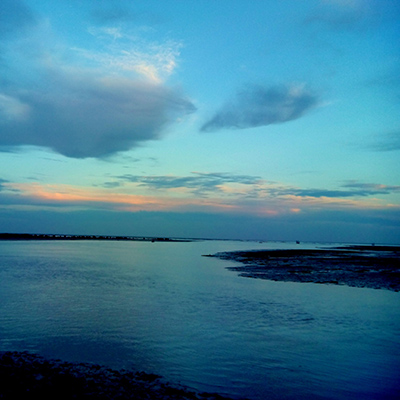Sites
Musa Bay
Written by: Maryam Latifi
Translated by: Hadi Qorbanyar
78 Views
Musa Bay is a bay at the northwest end of the Persian Gulf. It is located in the Bandar Imam Khomeini District, Mahshahr County, Khuzestan. Musa Bay runs north to Bandar Mahshahr and west to the Bahmanshir River. Its mouth is about 150 meters wide, with an average width of around 37 kilometers. Near Bandar Imam Khomeini, it narrows to approximately 2 kilometers and extends nearly 77 kilometers to the north and northwest, before turning eastward and ending at Bandar Mahshahr. Musa Bay is 20-50m deep, allowing ocean-going vessels to pass through it with ease. Among the ports located on its shores are Buzi (at the end of Khordouraq), Bandar Mahshahr, and Bandar Imam Khomeini.[1] There are several uninhabited islands in Musa Bay, including Dara, Bouneh, and Qabr-e Nakhoda.[2] As for the name Musa Bay, historical and geographical sources suggest different views, the most well-known of which is that it was named after Musa, a famous captain.[3]
Musa Bay’s significance lies in its geographical location, which features Bandar Imam Khomeini with its modern cargo handling facilities and high berthing capacity, as well as the presence of Bandar Mahshahr along its shores and the vital access routes connecting both ports.[4] On 21 September 1980, a day before the full-scale invasion of Iran, Iraq targeted an Iranian ship named Azadi in this bay.[5]
With the start of Iraq’s invasion of Iran on 22 September 1980, the Iraqi army advanced along the Shalamcheh–Khorramshahr–Abadan axis, crossed the Karun River, seized the Abadan–Ahvaz Road, and then moved towards the Abadan–Mahshahr Road, thereby cutting it off and surrounding the entire region. As a result, Abadan was completely besieged by land. Under these circumstances, the only available supply route for supporting the Iranian forces stationed in Abadan was the waterway connecting Bandar Imam Khomeini to Musa Bay and the Bahmanshir River (Chouebdeh), where small cargo vessels had previously passed. This route played a key role in supplying the forces in Abadan until the Shahid Shahshahani (Vahdat) Road was built.[6]
With the shutdown of the ports of Abadan and Khorramshahr due to the war, Iraq’s efforts to create insecurity and block the Musa Bay waterway intensified. The Iraqis were trying to prevent the passage of commercial ships to Bandar Imam Khomeini. On October 15, 1980, the tugboat Payam and the ship Navid, en route from Musa Bay to Bandar Abbas, were attacked by two Iraqi MiGs.[7] On October 25, 1981, two commercial ships—one Iranian and one Indian—that had unloaded their cargo and were leaving Bandar Imam Khomeini came under Iraqi missile attack. The ship Iran Rezvan was sunk near Musa Bay, while Vish Vishu Mitra caught fire.[8]
On the 6th of June 1982, the Greek vessel Koudlak, carrying 27,000 tons of urea fertilizer, was attacked by Iraqi aircraft.[9] On June 26, another Greek ship in Musa Bay was struck by an Iraqi missile and caught fire.[10] On August 9, 1982, the Greek ship Liston Bride and the vessel Bunosambo, leased by South Korea, were hit by helicopter rockets after unloading their cargo at Bandar Mahshahr; Liston Bride sank as a result.[11] On September 4, 8, 9, 11, and 13; September 17; and December 18, 1982, Iraq attacked Iranian and foreign ships passing through Musa Bay.[12] Likewise, on January 2, 1983, eight commercial vessels en route from Bushehr to Bandar Imam Khomeini were targeted at the mouth of Musa Bay. In this attack, the Singaporean ship Eastern Hunter and the Liberian ship Ardit Horizon sustained damage.[13] These assaults were carried out by helicopters, aircraft, and missile bases stationed at Ras al-Bisheh.[14]
In response to such attacks, the Iranian military command implemented a convoy policy in 1983 to safeguard maritime traffic along key export routes in the northern Persian Gulf. Accordingly, ships traveling between Bushehr, Bandar Imam Khomeini, and Mahshahr would sail about every 10 to 20 days based on how many were involved. Iranian Air Force fighter jets, Army Aviation (Havanirooz) and Oil Company helicopters, Iranian Navy missile boats, armed speedboats, and Islamic Revolutionary Guard Corps (IRGC) tugboats would escort the ships to protect them and ensure their safety.[15] Despite these measures, Iraq often found out about the movement timings of convoys and managed to carry out attacks. Although the Iranian air-defense systems provided limited protection, in many cases, several vessels in a convoy would be hit by Iraqi rockets.[16] For instance, on September 12, 1983, Iraq launched an airstrike on a convoy of 21 ships headed for Bandar Imam Khomeini, though without significant damage.[17] Also, on October 12, 1983, a convoy of 19 ships leaving Bandar Imam Khomeini was attacked as a result of which the ship Iran Shahadat was hit by a missile in its engine room and sank.[18] On October 31 of the same year, a convoy of 20 commercial vessels en route to Bandar Imam Khomeini came under attack when Iraq launched three missiles into their transit corridor. One of the missiles struck the Greek ship Ora, which was carrying 10,000 tons of urea fertilizer, causing a fire.[19] On November 21, 1983, 23 commercial ships transporting goods from Bushehr to Bandar Imam Khomeini for unloading, along with 17 others that had completed unloading and were awaiting departure, came under Iraqi attack near Musa Bay, resulting in damage to two cargo vessels.[20] Additional attacks on convoys heading to or departing from Bandar Imam Khomeini occurred on December 8, 1983; April 25; July 1 and 10; and August 11, 1984.[21]
With the launch of the first phase of Bandar Shahid Rajaee in Bandar Abbas in 1984, and its subsequent expansion through the end of the war, ship traffic through Musa Bay was significantly reduced, effectively neutralizing Iraqi military attacks in this area.[22]
After the war, efforts were made to reconstruct and repair the damaged docks, facilities, and equipment at Bandar Imam Khomeini and Bandar Mahshahr. As a result, maritime traffic through the waterway gradually recovered its former vitality.[23]
During the eight-year war, seven vessels had sunk in Musa Bay. After the war, their removal became a priority in order to clear the waterway’s access route, enhance navigational safety, reduce accidents and obstacles, protect the marine environment, and lower dredging costs. This operation continued until 2018.[24]
In addition to the war-related wrecks, vessels that sank in the waterway due to accidents have also been considered for removal. For example, in late 2021, the vessel Sara, which had sunk in 2005 following an accident in Musa Bay, was recovered.[25]
Dredging of the Musa Bay access channel has been carried out on a continuous basis to increase capacity, improve vessel safety, and enable 24-hour navigation for ships of up to 80,000 tons. The most recent dredging operation began in February 2021 and by January 2023 had reached 71 percent completion.[26]
[1] Haddad Adel, Gholam-Ali (ed.), Daneshname-ye Jahan-e Islam (Encyclopedia of the Islamic World), Vol. 16, Tehran: Bonyad-e Dayereh-ye Maarref-e Eslami, 1375, p. 438.
[2] Sobhani, Ebrahim, Khorrmusi (Musa Bay), Majale-ye Olum-e Ensani-ye Daneshgah-e Sistan va Baluchestan, No. 4, Bahar va Tabestan 1376, p. 75.
[3] Qayem, Bahador, Tarikh-e Hashtad Sal-e Bandar-e Imam Khomeini (Eighty-Year History of Bandar Imam Khomeini), Isfahan: Homay-e Rahmat, 1388, Pp. 61-67.
[4] Bakhtiari, Masoud, Bandar-e Imam Khomeini va Siyadat-e Daryayi (Bandar Imam Khomeini and Maritime Supremacy), Tehran: Iran Sabz, 1391, p. 13.
[5] Soleimankhah, Nematollah, Tasmim-e Saddam be Jang-e Alayh-e Iran: Laghv-e Yek Janebe Moahde-ye 1975 al-Jazayir (Saddam’s Decision to Wage War on Iran: Unilateral Cancellation of the 1975 Algiers Agreement), Tehran: Markaz-e Asnad va Tahqiqat-e Defa Muqaddas, 1394, p. 1175.
[6] Lotfollahzadegan, Ali-Reza, Hoveyzeh, Akharin Qadam-ha-ye Eshghalgar: Zamingir Shodan va Tavaqof-e Kamel-e Doshman (Hoveyzeh, Last Steps of the Invader: Grounded and Fully Stopped), Tehran: Sepah-e Pasdaran-e Enqelab-e Eslami, Markaz-e Asnad va Tahqiqat-e Defa Muqaddas, 1373, Pp. 75-77; Bakhtiari, Masoud, Ibid., p. 11.
[7] Sadeqi-Goya, Nejatali, Defa Abadan: Defa Abadan dar Sal-e Avval-e Jang-e Tahmili (Defense of Abadan: Defending Abadan in the First Year of the Imposed War), Tehran: Iran Sabz, 1391, p. 61.
[8] Lotfollahzadegan, Ali-Reza, Azad-sazi-ye Sarzamin-ha-ye Iran – Qadam-e Dovom: Bostan; Oojgiri-ye Teror-haye Koor, Tashkil-e Dowlat pas az Bohran (Liberation of Iranian Lands – Step Two: Bostan; Rise of Blind Terror, State Formation After the Crisis), Tehran: Sepah-e Pasdaran-e Enqelab-e Eslami, Markaz-e Asnad va Tahqiqat-e Defa Muqaddas, 1394, p. 309.
[9] Habibi, Abolqasem, Azad-sazi-ye Khorramshahr: Payan-e Royay-e Tajziye-ye Iran (Liberation of Khorramshahr: End of Iran’s Partition Dream), Tehran: Sepah-e Pasdaran-e Enqelab-e Eslami, Markaz-e Asnad va Tahqiqat-e Defa Muqaddas, 1379, p. 798.
[10] Lotfollahzadegan, Ali-Reza, Oboor az Marz: Taaqib-e Motajavez ba Amaliat-e Ramazan (Crossing the Border: Pursuit of the Aggressor with Operation Ramazan), Tehran: Sepah-e Pasdaran-e Enqelab-e Eslami, Markaz-e Asnad va Tahqiqat-e Defa Muqaddas, 1381, p. 73.
[11] Ibid., p. 575.
[12] Lotfollahzadegan, Ali-Reza, Amaliat-e Moslem ibn Aqil: Azadi-ye Ertefaat-e Somar va Tahdid-e Mandali – Tasvib-e Qatname-ye 522 Shoraye Amniyat (Operation Moslem ibn Aqil: Liberation of Somar Heights and Threat to Mandali – Adoption of UNSC Resolution 522), Tehran: Sepah-e Pasdaran-e Enqelab-e Eslami, Markaz-e Asnad va Tahqiqat-e Defa Muqaddas, 1391, Pp. 203, 252, 267, 295, 317, 371; Lotfollahzadegan, Ali-Reza, Valfajr Moqadamati: Dastgiri Markaziyat-e Hezb-e Tude va Afzayesh-e Tiregi-ye Ravabet ba Shoravi (Preliminary Valfajr: Closing the Tudeh Party Central Command and Worsening Relations with the USSR), Tehran: Sepah-e Pasdaran-e Enqelab-e Eslami, Markaz-e Asnad va Tahqiqat-e Defa Muqaddas, 1392, p. 50.
[13] Ibid., p. 167.
[14] Lotfollahzadegan, Ali-Reza and Iraj Hemmati, Avalin Amaliat-e Bozorg dar Shomal-e Gharb: Valfajr 4 (First Major Operation in Northwest: Valfajr 4), Tehran: Sepah-e Pasdaran-e Enqelab-e Eslami, Markaz-e Asnad va Tahqiqat-e Defa Muqaddas, 1397, p. 426.
[15] Ibid., Pp. 39-40.
[16] Nemati, Yaqoub va Digaran, Amade-sazi-ye Amaliat-e Valfajr4: Tajhiz-e Araq be Jangandeh-ha-ye Superstandard; Tahdid-e Iran be Basteh Kardan-e Tangeh-ye Hormoz (Preparation of Operation Valfajr4: Equipping Iraq with Super Standard Fighters; Threating to Close the Strait of Hormuz), Tehran: Sepah-e Pasdaran-e Enqelab-e Eslami, Markaz-e Asnad va Tahqiqat-e Defa Muqaddas, 1394, p. 426.
[17] Ibid.
[18] Ibid., p. 1043.
[19] Lotfollahzadegan, Ali-Reza and Iraj Hemmati, Ibid., p. 436.
[20] Ibid., Pp. 810-811.
[21] Ibid., p. 1035; Yazdanfam, Mahmoud, Aghaz-e Jang-e Naftkesh-ha: Tavafoq-e Gheyre Mostaqim baraye Ghate Hamalat be Mantaqe-ye Maskooni (Start of the Tanker War: Indirect Agreement to Stop Attacks on Residential Areas), Tehran: Sepah-e Pasdaran-e Enqelab-e Eslami, Markaz-e Asnad va Tahqiqat-e Defa Muqaddas, 1397, Pp. 100, 791, 875; Nemati-Varojeni, Yaqoub and Hojjatollah Karimi, Rokood dar Jebhe; Taharrok dar Diplomasi (Stagnation at the Front; Activity in Diplomacy), Tehran: Sepah-e Pasdaran-e Enqelab-e Eslami, Markaz-e Asnad va Tahqiqat-e Defa Muqaddas, 1398, p. 473.
[22] Qayem, Bahador, Ibid., p. 202; Bakhtiari, Masoud, Ibid., p. 23.
[23] Bakhtiari, Masoud, Ibid.
[24] Keyhan (Keyhan Newspaper), No. 21643, 20/3/1396, p. 7; https://www.isna.ir/news/97061306604
[25] https://www.mehrnews.com/news/5357073
[26] Donya-ye Eqtesad (Donya-ye Eqtesad Newspaper), No. 1002, 20/4/1385, p. 27; Resalat (Resalat Newspaper), No. 7128, 18/8/1389, p. 16; https://mana.ir/fa/news/94814





